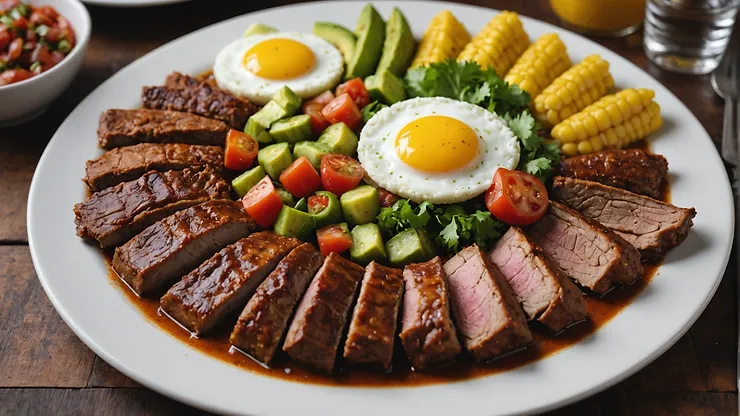My Journey Through Colombia’s Diverse Food Culture: A Personal Exploration
After two years of exploring Colombia’s rich culinary landscape, I’ve discovered that calling it simply “Colombian food” doesn’t do justice to the incredible diversity I’ve encountered. From the Caribbean coast to the Andean highlands, each region tells its own unique story through food, and I’m excited to share my personal journey through this gastronomic paradise.

The Caribbean Coast: Where Africa Meets Spain
My first taste of Colombia’s diversity came in Cartagena, where the fusion of African and Spanish influences creates something entirely unique. Here’s what I discovered:
- Seafood Evolution: At La Cevicheria, a local chef explained how African cooking techniques transformed Spanish seafood recipes. The coconut-based seafood stews like cazuela de mariscos reflect this beautiful marriage of cultures.
- African Heritage: I learned that dishes like cayeye (mashed green bananas) and patacones (fried plantains) trace their roots directly to African cooking traditions, brought here centuries ago.
My favorite discovery was enyucado, a cassava and coconut cake that my neighbor María teaches tourists to make. “This recipe,” she told me, “has been passed down through five generations of my family.”
The Andean Region: Indigenous Meets Colonial
Moving to Bogotá opened my eyes to a completely different Colombian cuisine:
- Ancient Grains: I found that quinoa and amaranth, traditional indigenous crops, are making a comeback in modern restaurants.
- Ajiaco Evolution: This traditional soup taught me how three different kinds of potatoes, each from different altitude zones, can create such complex flavors. My local soup vendor, Don Pedro, proudly explained how his family recipe dates back to his great-grandmother.
Pacific Coast: The Untold Story
The Pacific region surprised me with its unique ingredients and preparations:
- Piangua: These small black clams, harvested by local women, appear in dishes I’d never encountered before.
- Viche: A traditional fish soup that locals told me holds as much cultural significance as social sustenance.
“Our food is our identity,” explained Diana, a local chef in Buenaventura. “Each dish tells the story of our African ancestors and their connection to the Pacific.”
Amazon Region: Nature’s Pantry
My journey to the Amazon revealed ingredients I never knew existed:
- Indigenous Techniques: I learned about traditional smoking and fermentation methods that have been preserved for centuries.
- Exotic Fruits: Fruits like copoazú and arazá opened my eyes to flavors I didn’t know were possible.
The Coffee Region: Beyond Coffee
In the Coffee Triangle, I discovered that coffee culture extends far beyond the beverage:
- Coffee Gastronomy: Local chefs are incorporating coffee into traditional dishes in innovative ways.
- Farming Culture: The calentado breakfast tradition here reflects the hardy farming lifestyle that built the region.
Modern Colombian Fusion
Today’s Colombian chefs are writing new chapters in this diverse story:
- Fine Dining Revolution: Restaurants like Leo in Bogotá are elevating traditional ingredients to world-class status.
- Street Food Evolution: Even street food vendors are experimenting with fusion, like the arepas with Korean bulgogi I found in Medellín.
The Role of Local Markets
Each region’s local market tells its own story:
- Paloquemao Market, Bogotá: Here I discovered how highland ingredients make their way to urban tables.
- Bazurto Market, Cartagena: The spice mixtures here taught me about Caribbean Colombia’s connection to the spice trade.
Preserving Traditions While Embracing Change
What’s most impressive is how Colombia maintains its culinary heritage while embracing innovation:
- Traditional Cooking Schools: I attended classes where grandmothers teach traditional recipes to young chefs.
- Modern Interpretations: Young chefs are respectfully updating traditional dishes for contemporary palates.
Social Aspects of Colombian Food Culture
Perhaps most importantly, I’ve learned that Colombian food is about community:
- Family Gatherings: Sunday almuerzo (lunch) remains sacred, often lasting hours.
- Communal Cooking: Traditions like making tamales or sancocho often involve entire families or neighborhoods.
Environmental Considerations
Today’s Colombian food scene is also addressing sustainability:
- Farm-to-Table Movement: Many restaurants now work directly with small farmers.
- Indigenous Agriculture: Traditional farming methods are being recognized for their environmental benefits.
Looking to the Future
Colombian cuisine continues to evolve:
- Food Tourism: Regions are developing culinary tours highlighting their unique contributions.
- Global Recognition: Colombian chefs are gaining international acclaim while staying true to their roots.
- Education Initiatives: Cooking schools are incorporating modules on regional diversity.
The journey through Colombia’s food culture has taught me that diversity isn’t just about different dishes – it’s about understanding how history, geography, and culture shape what we eat. Each meal tells a story of cultural exchange, resistance, adaptation, and creativity.
About the Author: After moving to Colombia in 2021, I’ve traveled extensively throughout the country, learning from local cooks, chefs, and food historians. I document traditional recipes and their stories to help preserve Colombia’s rich culinary heritage.